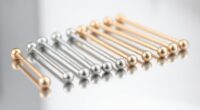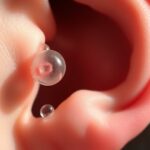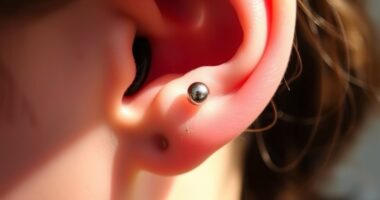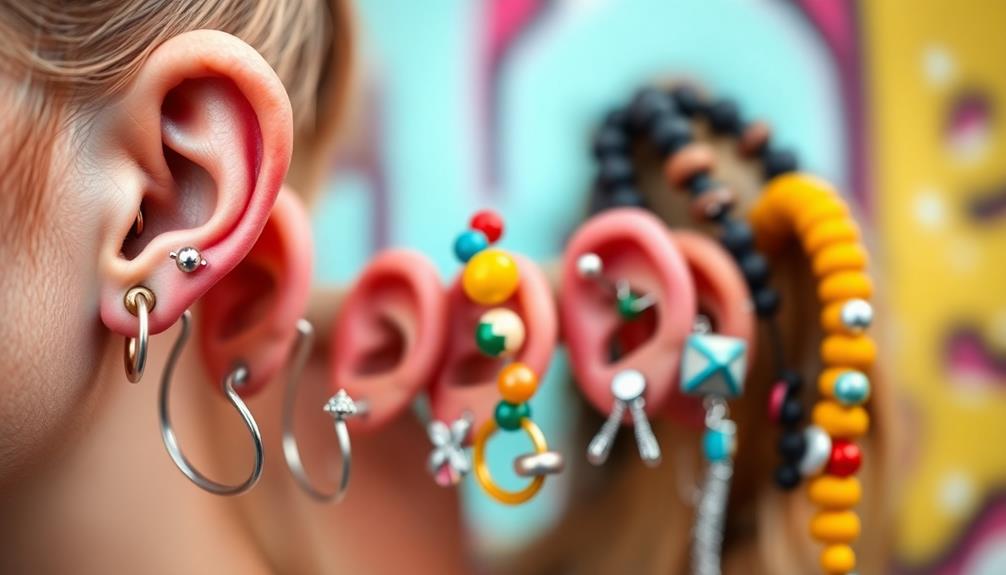Practicing inversions with fresh piercings increases risks like swelling, irritation, and infection, so it’s best to wait until they fully heal. During healing, inversions can put pressure on sensitive areas, causing discomfort or damaging the jewelry. To stay safe, avoid inversions that put strain on pierced sites, keep them clean, and consult with your piercer or healthcare provider beforehand. If you want to learn more about protecting your healing piercings during inversions, keep exploring these important precautions.
Key Takeaways
- Avoid inversions until piercings are fully healed to prevent swelling, irritation, or infection.
- Use supportive props and modify poses to reduce pressure on fresh pierced areas during inversions.
- Consult your piercer or healthcare provider before attempting inversions with new piercings.
- Prioritize gentle, supported inversions over full headstands to minimize risk during healing.
- Maintain good hygiene by cleaning piercings after practice and avoiding touching jewelry unnecessarily.

Practicing yoga inversions with fresh piercings can be risky if you’re not careful. When you’re healing from a new piercing, your body is working hard to recover, and any added stress or pressure can interfere with that process. Inversions, which involve turning your body upside down or elevating your legs, put increased pressure on certain areas, especially where your piercing placement is located. This heightened pressure can cause swelling, irritation, or even infection if you’re not cautious. It’s vital to consider how your healing process might be affected before attempting inversions, as these poses can disrupt the delicate balance your body needs to recover.
Avoid inversions during healing to prevent swelling, irritation, and infection at fresh piercing sites.
The healing process varies depending on the piercing placement. For example, facial or cartilage piercings tend to take longer to heal and are more sensitive to pressure and impact. Piercings on the nose, ears, or eyebrows are particularly vulnerable during inversions because gravity and weight distribution can cause discomfort or shift the jewelry. These areas are prone to swelling or accidental bumping, which can prolong healing or lead to complications. If your piercings are fresh, it’s best to wait until they’re fully healed before engaging in inversions. Generally, piercing sites need at least several weeks to months to heal completely, and even then, you should assess how stable and comfortable your jewelry feels.
Even if your piercing looks healed externally, the inside might still be tender, and inversions can exacerbate internal swelling or cause the jewelry to migrate. The key is to listen to your body and be mindful of any pain, tenderness, or unusual sensations. During the healing process, avoid putting unnecessary pressure on the piercing sites. If you’re determined to do inversions, consider modifying your poses or using props to reduce strain on your piercing placement. For instance, instead of full headstands or shoulder stands, opt for gentle supported inversions that keep pressure away from the pierced areas.
In addition, maintaining good hygiene is vital. Fresh piercings are more susceptible to infection, especially when exposed to sweat and bacteria during physical activity. After practicing, make sure to clean your piercings thoroughly and avoid touching or fiddling with jewelry. Proper healing is crucial to prevent setbacks and complications. Ultimately, patience is key; rushing into inversions too soon can compromise your healing and lead to setbacks. Consult with your piercer or healthcare provider about your specific piercing placement and the safest time to resume advanced poses. Prioritizing your healing process ensures you enjoy your yoga practice without risking your health or delaying recovery.
Frequently Asked Questions
Can Piercings Affect Blood Circulation During Inversions?
Piercings can definitely influence blood flow during inversions, as they might restrict circulation or cause discomfort. When you invert, increased pressure on pierced areas may lead to circulation impact, making you feel dizzy or sore. To stay safe, avoid inversions with fresh piercings, and if you notice any pain or swelling, stop immediately. Always prioritize your comfort and health to prevent complications from circulation issues.
Are There Specific Piercing Types Safer for Inversions?
You ask if certain piercing types are safer for inversions. During piercing healing, some jewelry, like studs or rings, are less likely to cause discomfort or injury during inversion safety measures. To avoid complications, choose piercings that stay secure and don’t shift easily. Always wait until your piercing fully heals before attempting inversions, as fresh piercings are more vulnerable to irritation, swelling, or infection. Prioritize your healing process to enjoy yoga safely.
How Long Should I Wait Before Doing Inversions After Piercing?
Imagine the moment you’re eager to try inversions again. Before you do, consider the healing timeline for your piercing placement. Usually, it’s best to wait at least 6-8 weeks, but some piercings need longer. Rushing in too soon risks infection or damage. Trust your body’s signals and consult your piercer for personalized advice—patience now ensures safe, enjoyable inversions later.
Can Inversions Cause Jewelry to Get Lost or Damaged?
Inversions can cause jewelry to shift or get lost if you’re not careful. To guarantee jewelry security, always check that your piercings are secure before inversions, and consider removing jewelry if there’s any risk of damage. If you’re unsure, it’s safer to remove your jewelry entirely to prevent loss or damage. This precaution helps protect your piercings and avoid costly replacements or injuries during your practice.
What Signs Indicate a Piercing Is Irritated From Inversions?
Hold your horses—if your piercing’s acting up, it’s not a sign to ignore. You might notice redness, swelling, or pain, which indicate irritation. These signs increase the infection risk and can prolong healing time. During inversions, gravity can cause discomfort or movement that irritates the piercing. Pay close attention and avoid inversions if these symptoms appear, giving your piercing a chance to heal properly and avoid complications.
Conclusion
Remember, practicing yoga inversions with fresh piercings isn’t worth risking an infection or injury. Keep your piercings clean, avoid putting pressure on them, and listen to your body—don’t be tempted to emulate a Victorian acrobat in a grand circus tent. Patience is key; wait until your piercings heal completely. When in doubt, consult your piercer or healthcare provider. Stay safe, stay mindful, and enjoy your yoga journey without the drama of a scene from a bygone era.
I’m Gillian. I love piercings and tattoos- there’s something about the way they make your body look that just makes me happy. I started this blog to share my passion for piercings and tattoos with the world and to help people who are thinking of getting their first piercing or tattoo.
I’ve been writing about piercings and tattoos for a while now on piercings-body.com. I love sharing my knowledge with others and helping people make informed decisions about their bodies.

















